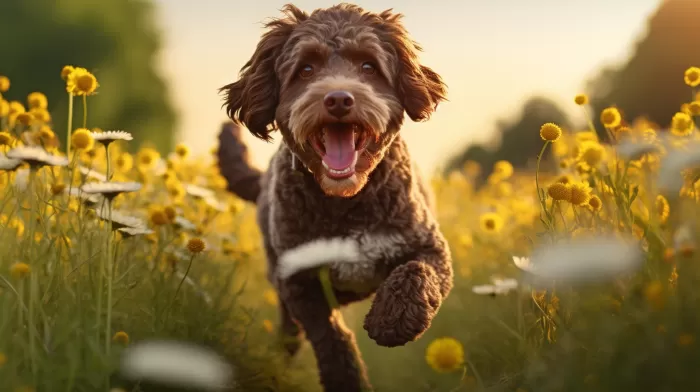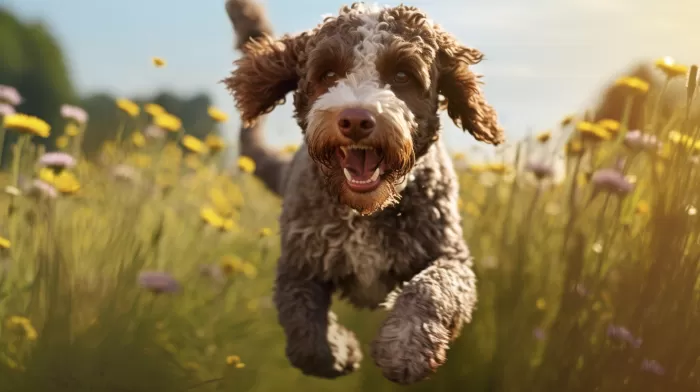Beneath a canopy of Italian trees in the early 19th century, the Lagotto Romagnolo—also known as the Italian water dog—might have been unsuspectingly changing the course of modern canine diet debates. This truffle-hunting maestro, with its curly, waterproof coat and innate propensity for sniffing out gourmet treasures, was never merely frolicking through the woods; it was forging a lifestyle that contemporary pet owners now scrutinize under a dietary microscope.
Let’s delve into a question that seems to ruffle more than just fur: Should the Lagotto Romagnolo be fed a grain-free diet? Grain-free dog food has swept through pet aisles like a trend on tiptoes, and many owners have pirouetted right alongside, hoping to waltz into improved health for their furry companions. What’s the real score, and how does it fit into the narrative of such a distinctive breed as the Lagotto?
In the world of dog diets, grain-free food touts a promise of purity, echoing the ancestral eating habits of wild canines. Critics, however, raise eyebrows and concerns about its nutritional adequacy. Grains have been part of domestic dog diets for decades, and they often provide essential nutrients. Yet some argue that because dogs – Lagottos included – have carnivorous roots, they might fare better on a diet that mirrors the meat-rich meals of their predecessors.
So, is the grain-free option the truffle of dog diets or just a well-marketed mushroom? First, let’s unravel that glorious double-coated breed: the Lagotto Romagnolo. Originally bred to hunt waterfowl in the marshlands of Italy, these dogs have an impressive history. But it’s not their past that’s fascinating—it’s their nose. They have an exceptional sense of smell, which has been repurposed from retrieving ducks to hunting one of the world’s most expensive culinary specialties: truffles.
What does a truffle-sniffing dog’s diet have to do with grains, you ask? It’s about matching diet to activity level. Truffle hunting is demanding; it requires endurance, keen senses, and a dash of problem-solving. A Lagotto needs fuel that is up to the task. The grain-free camp suggests that carbohydrates from grains can cause blood sugar spikes, leading to energy crashes that won’t suit a working dog’s lifestyle.
However, there’s more to the story. Not all calories are created equal. Quality is crucial and grains aren’t the villain they’re often portrayed to be. Whole grains, like brown rice and oats, can provide sustained energy, fiber for digestion, and essential fatty acids. They’re not just fillers; they’re fuel sources filled with vitamins and minerals too, which can be beneficial for a dog’s overall health.
While supporters of grain-free diets point out that dogs can get the necessary nutrients from vegetables and meats, it’s worth noting that some grains may offer what meat can’t. For example, whole grains like quinoa include all nine essential amino acids that dogs need, making it an excellent protein source for our four-legged friends.
Then there’s the debate spurred by recent FDA investigations linking grain-free diets to an increased risk of canine dilated cardiomyopathy (DCM), a heart condition. This poses a serious question: Is a grain-free diet a healthful choice or a ticking time bomb?
Considering the potential risks associated with grain-free diets, one might immediately lean towards including grains. Nonetheless, it’s essential to understand that Lagotto Romagnolos are individuals, each with unique nutritional needs. While one might thrive on a rural Italian farm with a grain-free menu, another in a New York City apartment could perhaps fare better with a mix of meat and grains.
The key lies in balance and understanding that the best diet for a Lagotto—or any dog is one tailored to its specific needs. This could mean consulting with a vet or canine nutritionist, noting the dog’s energy levels, and observing any dietary reactions over time.
If you are considering grain-free for your Lagotto Romagnolo, it’s vital to scrutinize ingredient lists. A grain-free label doesn’t always equate to high quality. Some grain-free options swap grains for legumes like lentils or chickpeas, which might lead to imbalanced amino acid profiles or insufficient taurine—a nutrient vital for heart health.
Another point in the grain debate relates to sourcing. Responsible grain farming and organic practices can make a significant difference in the quality of grains in dog food. Conversely, it’s also vital to ensure that the grain-free ingredients are just as responsibly sourced and not simply alternative fillers.
Ultimately, to grain or not to grain is not a question with a one-size-fits-all answer. A dog’s health history, digestive system, and even breed-specific traits like those fascinating Lagotto Romagnolos can all come into play. Your lagotto might not converse with you over a bowl of pasta to give its preference, but its body will certainly communicate in other ways. Paying attention to those signals and getting professional dietary advice is key to tailoring that perfect Lagotto diet.
Remember, what truly matters is the quality of your furry friend’s life—filled with joy, good health, and perhaps, if it’s lucky, a truffle or two.



